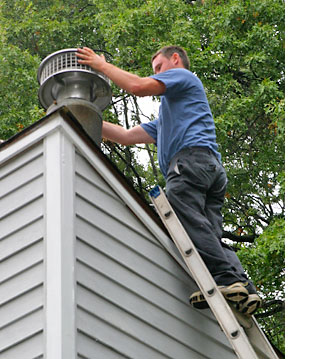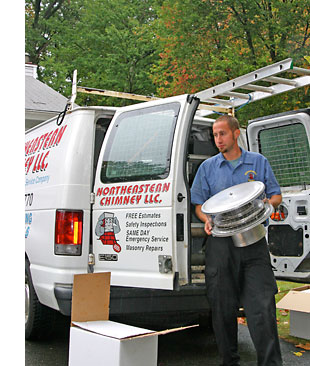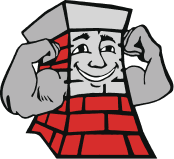How a Chimney Cap Installation Protects Your Home and Roof
 Getting drips of water in the fireplace and chimney when it rains or snows may be a common problem for homeowners with a missing or damaged chimney cap, but it can lead to potentially dangerous home and roof issues. Typically, when a home is built the chimney remains exposed. In some cases, a rudimentary cement chimney cap is built above the crown. Cement chimney caps are easily cracked, deteriorate over time and will eventually need to be replaced.
Getting drips of water in the fireplace and chimney when it rains or snows may be a common problem for homeowners with a missing or damaged chimney cap, but it can lead to potentially dangerous home and roof issues. Typically, when a home is built the chimney remains exposed. In some cases, a rudimentary cement chimney cap is built above the crown. Cement chimney caps are easily cracked, deteriorate over time and will eventually need to be replaced.
Prevent Clogged Chimneys
Even if you close the damper during inclement weather snow, water, pests, small animals and other debris will still get in the flue. As the debris continues to grow it can ultimately clog the chimney preventing the escape of dangerous carbon monoxide gases and other harmful contaminants the next time the fireplace is used. In fact, there are thousands of emergency room visits and approximately 200 deaths each year due to carbon monoxide poisoning in the home, according to the U.S. Consumer Product Safety Commission.
Minimize Water Damage
Additionally, water is one of chimney’s worst enemies. It can soften the masonry and rust out the smoke shelf and other metal components resulting in expensive chimney repairs. The soften masonry also leads to spalling and missing bricks which diminishes the structural integrity of the chimney. The spalling and missing bricks need to be repaired and replaced to prevent carbon monoxide leaks and other structural issues. Without a chimney cap, heavy snow, water and ice can build up on the roof near the chimney and cause roof damage. Also, lighting a fireplace in a wet chimney is dangerous and can cause a large plume of smoke filled with ash and creosote to back up into your home.
Reduce Fire Hazard
When you’re burning your fireplace do you ever wonder where the burning embers go? Well without a chimney cap, the burning embers that are not extinguished inside the chimney escape through the flue. This is a potential fire hazard as flying burning embers could spark a roof fire. Our chimney caps have a safety device called a spark arrestor to help prevent roof and chimney fires.
Eliminate Downdrafts and Foul Odors
 Many homeowners with an exposed chimney have complained of foul odors in the home. This can occur during a downdraft. On windy days when high pressure builds on the roof, the chimney acts like a vacuum sucking in air. The force of the downdraft pushes down the soot and other debris into the chimney that can stink up the home with an unpleasant odor. The downdraft can also build enough strength to blast open glass fireplace doors spilling ash on the floor, furniture and throughout the room. The situation is even more dangerous if the fireplace is burning as the exhaust is pushed into your home. A chimney cap can minimize the dangerous effects of a downdraft.
Many homeowners with an exposed chimney have complained of foul odors in the home. This can occur during a downdraft. On windy days when high pressure builds on the roof, the chimney acts like a vacuum sucking in air. The force of the downdraft pushes down the soot and other debris into the chimney that can stink up the home with an unpleasant odor. The downdraft can also build enough strength to blast open glass fireplace doors spilling ash on the floor, furniture and throughout the room. The situation is even more dangerous if the fireplace is burning as the exhaust is pushed into your home. A chimney cap can minimize the dangerous effects of a downdraft.
Chimney Cap Installation
Think of a chimney cap as a roof for the chimney. This steel or copper device with a metal wire mesh may seem simple, but it is an extremely valuable safety device that provides additional protection for your home and family. They are very affordable and are installed by a certified chimney repair specialist. They are available in a variety of attractive designs for both single flue and multi-flue chimneys.


